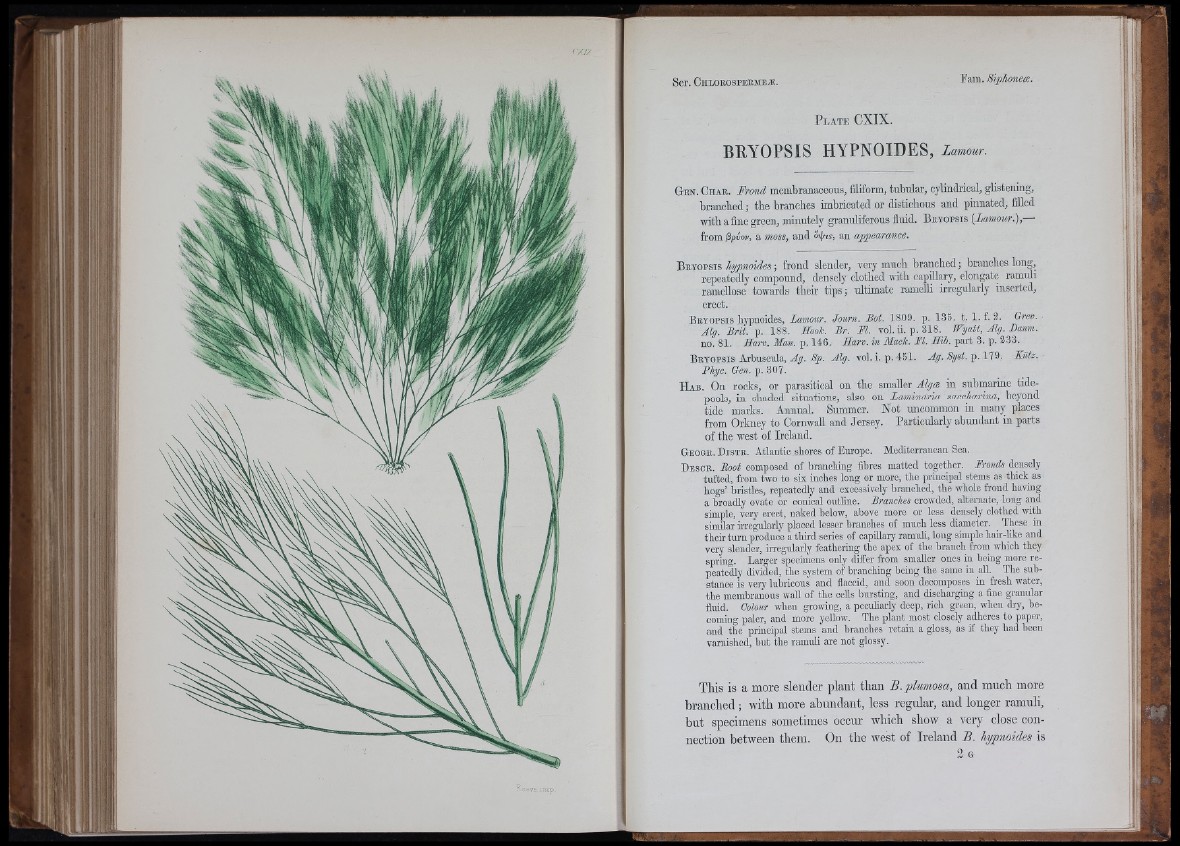
P la t e CXIX.
BRYOPSIS HYPNOIDES, Lamour.
Gen . Chae. Frond membranaceous, filiform, tubular, cybndrical, glistening,
branched; the branches imbricated or distichous and pinnated, filled
with a fine green, minutely granuliferous fluid. B ryopsis {Lamour.),—■
from Spvov, a moss, and o fis, an appearance.
liypnoides ; frond slender, very much branched; branches long,
repeatedly compound, densely clothed with capillary, elongate ramuli
ramellose towards their tips; ultimate ramelli irregularly inserted,
erect.
Bryopsis hvpnoides, Lamour. Journ. Bot. 1809. p. 135, t. 1. f. 3. Grev.
Alg. B r il p. 188. HooJc. Br. FI. vol. Ü. p. 318. Wyatt, Alg. Lanm.
no. 81. Harv. Man. p. 146. Harv. in Mack. FI. Hib. part 3. p. 233.
B r y o p s i s Arbuscula, Ag. Sp. Alg. v o l. i . p . 4 6 1 . Ag. Syst. p . 1 7 9 . Kütz.
Phyc. Gen. p . 307.
H ab. On rocks, or parasitical on the smaller A lg a in submarine tide-
pools, in shaded situations, also on Laminaria saecharina, beyond
tide marks. Annual. Summer. Not uncommon in many places
from Orkney to Cornwall and Jersey. Particularly abundant in parts
of the west of Ireland.
Geogr. Distr. Atlantic shores of Europe. Mediterranean Sea.
Descr. Boot composed of branching fibres matted together. Fronds densely
tufted, from two to six inches long or more, the principal stems as thick as
hogs’ bristles, repeatedly and excessively branched, the whole frond having
a broadly ovate or conical outline. Branches crowded, alternate, long and
simple, very erect, naked below, above more or less densely clothed with
similar irregularly placed lesser branches of much less diameter. ^ These in
their turn produce a third series of capillary ramuli, long simple hair-like and
very slender, iiTegularly feathering the apex of the branch from which they
spring. Larger specimens only differ from smaUer ones in being more repeatedly
divided, the system of branching being the same in aU. The substance
is very lubricous and flaccid, and soon decomposes in fresh water,
the membranous waU of the ceUs bursting, and discharging a fine granular
fluid. Colour when growing, a peculiarly deep, rich green, when dry, becoming
paler, and more yellow. The plant most closely adheres to paper,
and the principal stems and branches retain a gloss, as if they had been
varnished, but the ramuli are not | ’
This is a more siender piant than Li. plumosa, and much more
branched; with more abundant, iess regular, and longer ramuli,
but specimens sometimes occur which show a very close connection
between them. On the west of Ireland B. liypnoides is
O l
ii:
■lup